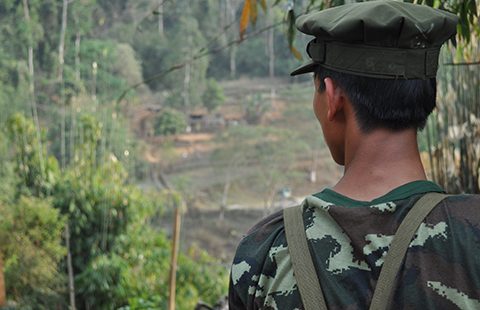
Kachin soldier. Photo by Allyson Neville-Morgan on flickr https://www.flickr.com/photos/anevillemorgan/
2015 Myanmar/Burma Update: piecemeal actions, third parties and a reformed military (on Facebook) help drive the peace process.
One of the most pressing issues facing Myanmar’s current transition, borderland conflicts and peace negotiations, was in sharp focus during the 2015 Myanmar/Burma Update.
The conference’s first panel of two provided analysis of the peace process and its key actors, the outcomes of the country’s ceasefire agreement and the changing role of the military.
Sketching the evolution of the current peace process following the election in 2011, Dr Min Zaw Oo of the Myanmar Peace Center said the process had ushered in a “very unique setup in the beginning of the transition, using people outside of the government.” This was demonstrated by the negotiating team led by U Aung Myint first reaching out to ethnic armed groups.
Min Zaw Oo went on to describe how the peace process gained momentum with rounds of negotiations between 16 armed groups and the government, emphasising the new role of the Myanmar Peace Center. Formed in 2012 the centre has “a mandate to facilitate the process but without authority over the procedure and the process,” Min Zaw Oo said.
The main outcome of the peace process was the signing of a draft ceasefire agreement in March 2015, with implications that “go beyond ceasefire, as a lot of political issues are embedded in it,” said Min Zaw Oo. The most notable of which is the recognition of union based on federalism, unthinkable in the past and now “in writing, part of an official document.”
Ma Su Mon Thazin Aung – of the University of Hong Kong – shed light on how the government was able to move the peace process forward despite “significant political, security and technical constraints,” citing the “piecemeal approach” of Min Zaw Oo’s centre as “crucial to the peace process.”
This led to the strategy of “resolving one issue at a time,” leaving sensitive issues such as the question of a federal army out of the draft National Ceasefire Agreement while still driving forward the key idea of a federal union. Ma Su Mon Thazin Aung also noted that the MPC has changed the nature of the peace policy process, serving as “much more than just a secretariat.”
Giving a first-hand account of his experiences as a Kachin representative in the Upper House, and qualified by Nicholas Farrelly as a “vote-winning machine” parliamentarian U Hkyet Thing Nan brought his personal experiences of the peace process to the discussion.
In 2011, he said, peace talks between the government and ethnic armed groups took place in China, as “we couldn’t talk about peace in our country because we couldn’t trust each other.”
U Hkyet Thing Nan went on to illuminate the key developments in the peace process, highlighting the formation of two peace committees by the government; the creation of the NCCT (National Ceasefire Coordination Team) made up of 16 armed groups, and the role of third parties including the UN and China in helping to build trust.
“I proposed to the parliament to involve third parties in the peace process, as at that time the conflict between the government and the KIO was very intense,” he said.
U Hkyet Thing Nan ended on the optimistic message that “even if citizens think that process takes time, we will try to adopt the peace agreement before the 2015 elections.”
Nicholas Farrelly from ANU rounded out the session with an image of Senior General Min Aung Hlaing’s Facebook page which has more than 195,000 ‘likes’; showing how the Tatmadaw is “making all sorts of adjustments” to keep up with the country’s rapidly changing face.
Describing the overall terrain of Myanmar society as changing in “astonishing ways,” Farrelly cited an increased awareness of civil war and possible solutions among a more informed public with active discussions about issues of internally displaced people.
In the new context, having relinquished 75 per cent of its power to the parliament, the military cares more about its public face.
“The Tatmadaw never had to ask anyone to ‘like’ it…now things have changed,” Farrelly said.
Amy Doffegnies and Cecile Medail are PhD scholars researching Myanmar at UNSW Canberra.
 Facebook
Facebook  Twitter
Twitter  Soundcloud
Soundcloud  Youtube
Youtube  Rss
Rss 